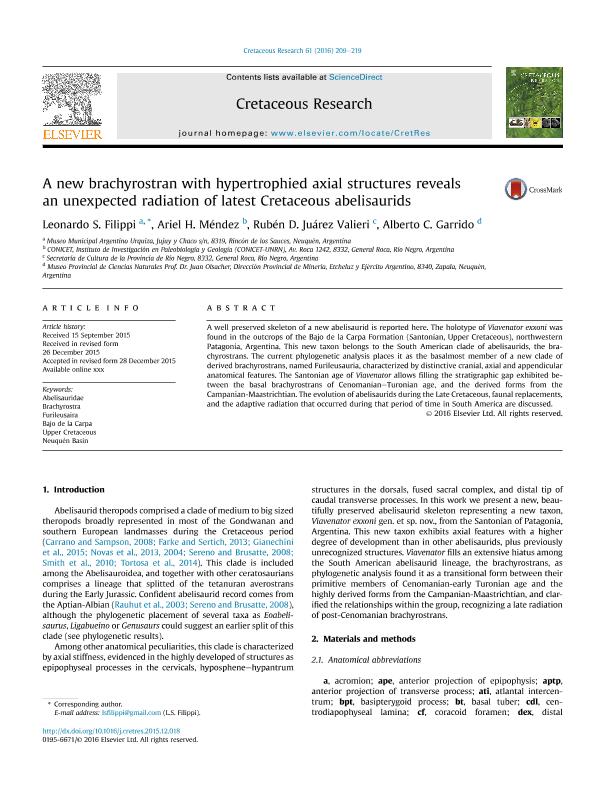Mostrar el registro sencillo del ítem
dc.contributor.author
Filippi, Leonardo Sebastián

dc.contributor.author
Méndez, Ariel Hernán

dc.contributor.author
Juárez Valieri, Rubén
dc.contributor.author
Garrido, Alberto Carlos

dc.date.available
2022-01-10T20:04:09Z
dc.date.issued
2016-06
dc.identifier.citation
Filippi, Leonardo Sebastián; Méndez, Ariel Hernán; Juárez Valieri, Rubén; Garrido, Alberto Carlos; A new brachyrostran with hypertrophied axial structures reveals an unexpected radiation of latest Cretaceous abelisaurids; Academic Press Ltd - Elsevier Science Ltd; Cretaceous Research; 61; 6-2016; 209-219
dc.identifier.issn
0195-6671
dc.identifier.uri
http://hdl.handle.net/11336/149906
dc.description.abstract
A well preserved skeleton of a new abelisaurid is reported here. The holotype of Viavenator exxoni was found in the outcrops of the Bajo de la Carpa Formation (Santonian, Upper Cretaceous), northwestern Patagonia, Argentina. This new taxon belongs to the South American clade of abelisaurids, the brachyrostrans. The current phylogenetic analysis places it as the basalmost member of a new clade of derived brachyrostrans, named Furileusauria, characterized by distinctive cranial, axial and appendicular anatomical features. The Santonian age of Viavenator allows filling the stratigraphic gap exhibited between the basal brachyrostrans of Cenomanian-Turonian age, and the derived forms from the Campanian-Maastrichtian. The evolution of abelisaurids during the Late Cretaceous, faunal replacements, and the adaptive radiation that occurred during that period of time in South America are discussed.
dc.format
application/pdf
dc.language.iso
eng
dc.publisher
Academic Press Ltd - Elsevier Science Ltd

dc.rights
info:eu-repo/semantics/openAccess
dc.rights.uri
https://creativecommons.org/licenses/by-nc-sa/2.5/ar/
dc.subject
ABELISAURIDAE
dc.subject
BAJO DE LA CARPA
dc.subject
BRACHYROSTRA
dc.subject
FURILEUSAIRA
dc.subject
NEUQUÉN BASIN
dc.subject
UPPER CRETACEOUS
dc.subject.classification
Paleontología

dc.subject.classification
Ciencias de la Tierra y relacionadas con el Medio Ambiente

dc.subject.classification
CIENCIAS NATURALES Y EXACTAS

dc.title
A new brachyrostran with hypertrophied axial structures reveals an unexpected radiation of latest Cretaceous abelisaurids
dc.type
info:eu-repo/semantics/article
dc.type
info:ar-repo/semantics/artículo
dc.type
info:eu-repo/semantics/publishedVersion
dc.date.updated
2021-04-23T14:05:06Z
dc.journal.volume
61
dc.journal.pagination
209-219
dc.journal.pais
Estados Unidos

dc.description.fil
Fil: Filippi, Leonardo Sebastián. Provincia de Neuquén. Museo Municipal Argentino Urquiza; Argentina
dc.description.fil
Fil: Méndez, Ariel Hernán. Universidad Nacional de Río Negro. Sede Alto Valle. Instituto de Investigaciones en Paleobiología y Geología; Argentina. Consejo Nacional de Investigaciones Científicas y Técnicas. Centro Científico Tecnológico Conicet - Patagonia Norte. Instituto de Investigación en Paleobiología y Geología; Argentina
dc.description.fil
Fil: Juárez Valieri, Rubén. Gobierno de la Provincia de Río Negro. Ministerio de Turismo, Cultura y Deporte. Secretaría de Cultura; Argentina
dc.description.fil
Fil: Garrido, Alberto Carlos. Provincia de Neuquén. Ministerio de Energía, Ambiente y Servicios Públicos. Dirección Provincial de Minería. Museo Provincial de Ciencias Naturales Prof. "Dr. Juan A. Olsacher"; Argentina
dc.journal.title
Cretaceous Research

dc.relation.alternativeid
info:eu-repo/semantics/altIdentifier/doi/http://doi.org/10.1016/j.cretres.2015.12.018
dc.relation.alternativeid
info:eu-repo/semantics/altIdentifier/url/https://www.sciencedirect.com/science/article/pii/S0195667115301439
Archivos asociados
